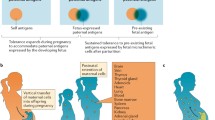Summary
The hypothesis that the Rh and ABO blood systems behave like the HLA system in relation to mother-conception tolerance-rejection mechanisms was tested in 25,501 mother-infant pairs. According to this hypothesis, heterozygotes carrying a paternal gene that is not present in their mother should be better tolerated than homozygotes. Significantly more BO infants born to AO mothers. AO infants born to BO mothers, Rh(+) heterozygotes born to Rh(-) mothers, and less significantly AO infants born to OO mothers confirm the hypothesis. Fewer homozygotes occurred in Rh(-) infants born to Rh(+) mothers and in O infants born to non-O mothers. Deviations from the Hardy-Weinberg equilibrium found in the ABO system were modified by the Rh and sex of the infant. These data strongly support the hypothesis that at least two feto-maternal systems influence the denstiny of pregnancies: the classical known incompatibility system which operates late in pregnancy and a new one which is based on the induction of maternal tolerance early in pregnancy: maternal tolerance seems to be better elicited by heterozygous eggs or embryos carrying a gene not present in the mother. The data also support the hypothesis that the sex ratio is influenced by feto-maternal tolerance-rejection mechanisms associated with the ABO and Rh systems.
Similar content being viewed by others
References
Aymé S, Mercier P, Dallest R, Mattei J-F (1984) HLA and trisomy 21. Confirmation of a trend of restricted HLA heterogeneity in parents of Down syndrome children. Am J Hum Genet 26:405–412
Caudle MR, Rote NS, Scott JR, De Witt C, Barney MF (1983) Histocompatibility in couples with recurrent spontaneous abortion and normal fertility. Fertil Steril 39:793–798
Chaventré A, Cazes MH, Roth A, Chaventré-Mano A, Fofana Y, Degos L, Brown Demonet E, Jacquart A (1981) Genétique des populations des isolats. In: Feingold J (ed) Genétique médicale. Chevilly-Larue, Inserm/Flammarion Medicine
Kirk RL, Shield JW, Stenhouse NS, Bryce LM, Jakobowicz R (1955) A further study of A-B-O blood groups and differential fertility among women in two Australian maternity hospitals. Br J Prev Soc Med 9:104–111
Krauss VA, Zimmermann D (1970) Die Vererbung der Blutgruppen A, B, O and Rh unter besonderer Berücksichtigung der Spätgestosen. Zentralbl Gynäkol 92:12–20
Li CC (1976) First course in population genetics. Boxwood Press, Pacific Grove
Morton NE (1982) Outline of genetic epidemiology. Karger, New York
Nordlander C, Fuchs T, Hammarstrom L, Smith CIE (1983) Human leukocyte antigens group A in couples with unexplained infertility. Fertil Steril 40:60–65
Ober CL, Martin AO, Simpson JL, Hauck WW, Amos DB, Kostyu DD, Fotino M, Allen FH Jr (1983) Shared HLA antigens and reproductive performance among Hutterites. Am J Hum Genet 35:994–1004
Pinto G, Ilic P, Paredes M, González T, Marinovic F, Valenzuela CY (1981) Frecuencias fenotípicas y génicas de los sistemas sanguíneos ABO y Rheusus en la Clínica Alemana (Santiago, Chile). Rev Med Chil 109:1209
Rock JA, Zacur HA (1983) The clinical management of repeated early pregnancy wastage. Fertil Steril 39:123–140
Salzano FM (1982) The microevolutionary process — a view from South America. Acta Anthropogenet 6:1–21
Schaap T, Shemer R, Palti Z, Sharon R (1984) ABO incompatibility and reproductive failure. I. Prenatal selection. Am J Hum Genet 36:143–151
Shield JW, Kirk RL, Jakobowicz R (1958) The ABO groups and masculinity of offspring at birth. Am J Hum Genet 10:154–163
Valenzuela CY (1985a) Interacciones selectivas entre los sistemas sanguínoes ABO, Rh y el sexo. Rev Med Chil 113:472–473
Valenzuela CY (1985b) Is there a lack of O (ABO system) newborn infants? Am J Hum Genet 37:611–613
Valenzuela CY, Harb Z (1977) Socioeconomic assortative mating in Santiago, Chile: A demonstration using stochastic matrices of mother-child relationships applied to ABO blood groups. Soc Biol 24:225
Valenzuela CY, Harb Z (1982) A mother-child segregation distortion for the Rh system. New evidence for another compatibility system associated with Rh. Am J Hum Genet 34:925–936
Valenzuela CY, Avendaño A, Harb Z, Acuña MP (1980) Grupos sanguíneos en escolares de un estudio longitudinal: Un extraño serendipismo. Rev Chil Pediatr 51:433–441
Valenzuela CY, Harb Z, Avendaño A, Acuña MP (1982) A large sibsib discordance for the Rh blood system. A possible new fetomaternal compatibility system. Am J Hum Genet 34:576–589
Valenzuela CY, Lyng C, Armanet L, Islas E, Harb Z, Acuña MP (1984) Anomalías segregacionales del sistema sanguíneo ABO asociadas al sistema Rh. Rev Med Chil 112:213–217
Author information
Authors and Affiliations
Rights and permissions
About this article
Cite this article
Valenzuela, C.Y., Walton, R. Selective interactions among Rh, ABO, and sex ratio of newborns. Hum Genet 71, 53–57 (1985). https://doi.org/10.1007/BF00295669
Received:
Revised:
Issue Date:
DOI: https://doi.org/10.1007/BF00295669




